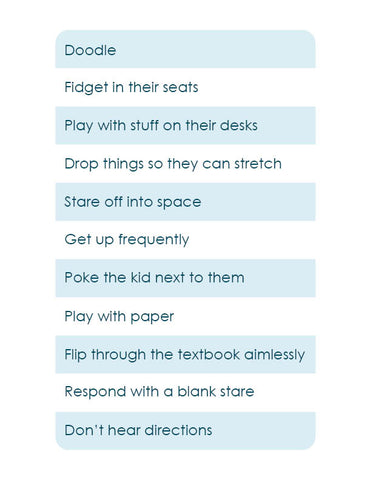Help! My Child is Struggling with Paying Attention!
One of the biggest challenges for teachers and parents alike is successfully capturing the attention of their students. When we teach, they need to listen and process what they hear, right?
What Paying Attention Looks Like
Traditionally the clearest signs of a child paying attention are that they are sitting still, making eye contact, and obviously listening. We can tell they are listening because of their interactions and reactions to what they are hearing. I believe this sort of attention is desired by every teacher out there! But for many children, this kind of attention just doesn't happen.

What Lack of Attention Looks Like

What is Behind Lack of Attention
Usually, situations aren’t as they appear on the surface. If half or more of students in a classroom aren’t paying attention, it isn’t necessarily that the teacher is lacking in skill. It is also not necessarily that the kids are naughty. There is probably something else going on.
1. According to *Dr. Carla Hannaford, neuroscientist and educator, up to 85% of students are kinesthetic. This little fact changes everything. Dr. Hannaford states that only 15% of children can process linearly, look at the teacher when they are talking and can repeat back what they heard. So, our dream of having attentive kiddos in class is not going to be realized. Not without some serious changing up. More about that later.2. What complicates the situation even more is that 75% of teachers match the profiles of the 15% of children who can sit still, listen, and repeat what they heard. Already there is a possible lack of communication between 75% of teachers and the 85% of children in their classrooms.

-
Are not auditory. This means their natural way of learning is not by listening. Kinesthetic children have to work very hard to take what they hear and translate that into images that they can understand and remember. And frankly, the motivation is usually just not there. It is too hard!
-
Learn while moving. Those things they are doing when not paying attention are happening because they are wired to move. They need to move. In fact, the more we try to get kinesthetic children to sit still and listen, the less they will be able to focus. Their focus goes naturally to creating ways that will let them move.
-
Think in pictures. Kinesthetic children are also right-brained learners who need the big picture, need to see how something relates to them, and who think in pictures, not words. Very motivated older children can learn to use their tendency to doodle to help them learn. They can doodle or sketch what they are hearing the teacher say and thus turn what they are hearing into pictures that they can make sense of and remember. Very young children need to be taught how to help themselves this way.

-
Are able to sustain focus when their hands are busy. Kinesthetic children can be spotted quite easily. Take a child who doesn’t listen, isn’t learning, and is constantly moving and give them a hands-on activity and watch what happens to their focus. If a child is truly kinesthetic and you give them a meaningful hands-on activity, the child will be able to focus just fine. By hands-on, I don’t mean pencil to paper, rather an activity that allows the child to work out the problem using real materials. More about this later.
- Don’t memorize and remember very easily. For example, math rules on how to solve a problem. In fact, they don’t memorize with good results, and if they do manage to memorize something, they don’t retain it in long-term memory. This is because they mostly learn visually and through movement.
Understanding Your Kinesthetic Learners
1. Just know that when they listen, it is likely they won’t be looking at you. Probably they will be looking off to the side, trying to turn words into pictures.
2. When giving directions, your kinesthetic kids will pay attention when you show them how to do something rather than telling them how to do it. This is because they are attuned to something they can see and they can imagine themselves actually doing the steps.
3. Focus will be on whatever their hands or body is doing, so when you teach something, give the kinesthetic child materials that are related to what you are saying and focus will follow. For example, instead of paper and pencil to learn about making change with money, use real objects with prices on them (or even pictures of items with prices) and let them actually count out coins and bills to make change.

4. If you encourage your kinesthetic learner to move in a way that will help them focus, everyone will be happier. The ground rules are these: The child has to be able to focus better than when just sitting at their desk quietly, and they cannot disturb anyone else. So, if the child needs to swing a leg, or even stand up and lean over the desk, that is fine. Maybe they need to pace the back of the room while reading.

5. Show the child you understand their learning strengths. The more they understand how they learn and have the tools that will help, the better things will go. Rather than being on the outs all the time, your kinesthetic kids will actually know how to help themselves excel. A kinesthetic child, even a very young one, can learn that they will focus better on a sheet of math problems if they use their pointer finger to point to each problem they work on.
6. Use resources that engage the child visually and with meaningful movement as they learn. In this way, you will not be trying to work around the child’s very natural way of learning. Let the resources work for you and for the child!
Consider Your Child’s Learning Environment
- Are your child’s resources, school work, and environment a match for the kinesthetic learner, and for your own child in particular?
- Do they match and enhance your child’s learning strengths?
Conclusion
If you feel your child’s learning environment or learning resources could better match your child’s natural learning strengths and you would like to discuss how to help, please contact us.
*Dr. Hannaford has 30 years of teaching experience, including 20 years as a professor of biology and 4 years as a counselor for elementary and intermediate school children with learning difficulties. She is an internationally recognized educational consultant since 1988, making more than 500 presentations world wide on the neural basis of learning. Dr. Hannaford has been recognized by Who’s Who in American Education.





Leave a comment